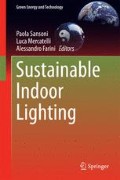Abstract
Appropriate lighting control is an essential part of any lighting system. It is usually implemented through a set of wired or wireless devices that connect them to the luminaires, with the aim of receiving input from the user, the environment, or from programmed routines, and of transmitting signals to modify the status of the lighting fittings, switching them on/off or dimming their emitted light flux. In some cases, the control system is also used to automatically manage the shading components installed in a building for glare and overheating protection.
Access this chapter
Tax calculation will be finalised at checkout
Purchases are for personal use only
References
Wood D (2004) Lighting upgrades: a guide for facility managers. The Fairmont press Inc, Lilburn
Pellegrino A (2010) Il progetto integrato: luce naturale - luce artificiale. In: a cura di M. Frascarolo, Manuale di progettazione illuminotecnica, vol 1. Mancosu Editore, Architectural Book and Review, Roma, pp D2–D12
Dilouie C (2006) Advanced lighting controls. Energy savings, productivity, technology and applications. The Fairmont press Inc, Lilburn
Dilouie C (2008) Lighting controls handbook. The Fairmont press Inc, Lilburn
Guo X, Tiller DK, Henze GP, Waters CE (2010) The performance of occupancy-based lighting control systems: a review. Lighting Res Technol 42:415–431
Richman EE, Dittmer AL, Keller JM (1994) Field analysis of occupancy sensor operation: parameters affecting lighting energy savings. PNL 10135, Pacific Northwest Laboratory, Richland
Maniccia D, Tweed A, Bierman A, Von NeIda W (2000) An analysis of energy and cost savings potential of occupancy sensor for commercial systems. J Illuminating Eng Soc IES, 16 June 2000
Jennings J, Colak N, Rubinstein FM (2001) Occupancy and time-based lighting controls in open offices. In: Proceeding of IESNA lighting conference
Pigg S, Eilers M, Reed J (1996) Behavioral aspects of lighting and occupancy sensors in private offices: a case study of a University office building. ACEEE 1996 Summer Study Energy Effi Build 8
Maniccia D, Rutledge B, Rea MS, Morrow W (1999) Occupant use of manual lighting controls in private offices. J Illuminating Eng Soc 28(2):42–56
Jennings J, Rubinstein FM, Di Bartolomeo D (2000) Comparison of control options in private offices in an advanced lighting control testbed. J Illuminating Eng Soc 29:39–60
Lee ES, Di Bartolomeo DL, Selkovitz SE (1998) Thermal and daylighting performance of automated venetian blind and lighting system in a full-scale private office. Energy Build 29(1):47–63
Choi AS, Mistrick RG (1999) Analysis of daylight responsive dimming system performance. Build Environ 34:3
Li DHW, Lam JC (2001) Evaluation of lighting performance in office buildings with daylighting controls. Energy Build 33(8):793–803
Lee ES, Di Bartolomeo D (2004) The effect of Venetian blinds on daylight photoelectric control performance. J Illum Eng Soc 1–21:2004
Lee ES, Selkowitz SE (2006) The New York Times Headquarters daylighting mockup: monitored performance of the daylighting control system. Energy Build 38:914–929
Galasiu AD, Atif MR, MacDonald RA (2004) Impact of window blinds on daylight-linked dimming and automatic on/off lighting controls. Solar Energy 76(5):523–544
Colaco SG, Kurain CP, George VI, Colaco AM (2008) Prospective techniques of effective daylight harvesting in commercial buildings by employing window glazing. Dynamic shading devices and dimming control—a literature review. In: Building Simulation, vol. 1. Tsinghua Press, Beijing
Doulos L, Tsangrassoulis A, Topalis F (2008) Quantifying energy savings in daylight responsive systems: the role of dimming electronic ballasts. Energy Building 40:1:36–50
Kobav MB, Bizjak G (2010) Long term study—energy savings obtained with use of daylight sensor and dimming ballasts. In: Proceeding of CIE 2010 lighting quality and energy efficiency, Vienna
Pellegrino A, Lo Verso VRM (2010) The energy demand for electric lighting as a consequence of different architectural building features and lighting plant characteristics. In: Commission Internationale de l’Eclairage, CIE Central Bureau (eds) Proceedings of CIE 2010 on lighting quality and energy efficiency, Vienna, Austria, 14–17 Mar 2010, pp 695–703
Maniccia D, Tweed A, Bierman A, Von Neida B (2001) The effects of changing occupancy sensor time-out setting on energy savings, lamp cycling and maintenance costs. J Illuminating Eng Soc 30:97–110
IEA ECBCS Annex 45 (2010) Guidebook on energy efficient electric lighting for buildings. In: Halonen L, Tetri E, Bhusal P (eds) Aalto University, School of Science and Technology, Department of Electronics, Lighting Unit, Espoo2010
Illuminating Engineering society of North America (2011) Lighting control protocols. IES Technical Memorandum 23-11
Simpson RS (2003) Lighting control: technology and applications. Focal Press, Oxford
EN 15193:2007: Energy performance of buildings. Energy requirements for lighting
Aghemo C, Blaso L, Pellegrino A, Serra V (2007) Energy consumption for electric lighting in buildings: the European Standard EN 15193 and its application, vol I. In: 62° Convegno Nazionale ATI, 11–14 Settembre 2007, Salerno, pp 145–150
Author information
Authors and Affiliations
Corresponding author
Editor information
Editors and Affiliations
Rights and permissions
Copyright information
© 2015 Springer-Verlag London
About this chapter
Cite this chapter
Pellegrino, A., Blaso, L. (2015). Lighting Control Strategies and Energy Efficiency Benefits. In: Sansoni, P., Mercatelli, L., Farini, A. (eds) Sustainable Indoor Lighting. Green Energy and Technology. Springer, London. https://doi.org/10.1007/978-1-4471-6633-7_16
Download citation
DOI: https://doi.org/10.1007/978-1-4471-6633-7_16
Published:
Publisher Name: Springer, London
Print ISBN: 978-1-4471-6632-0
Online ISBN: 978-1-4471-6633-7
eBook Packages: EngineeringEngineering (R0)

